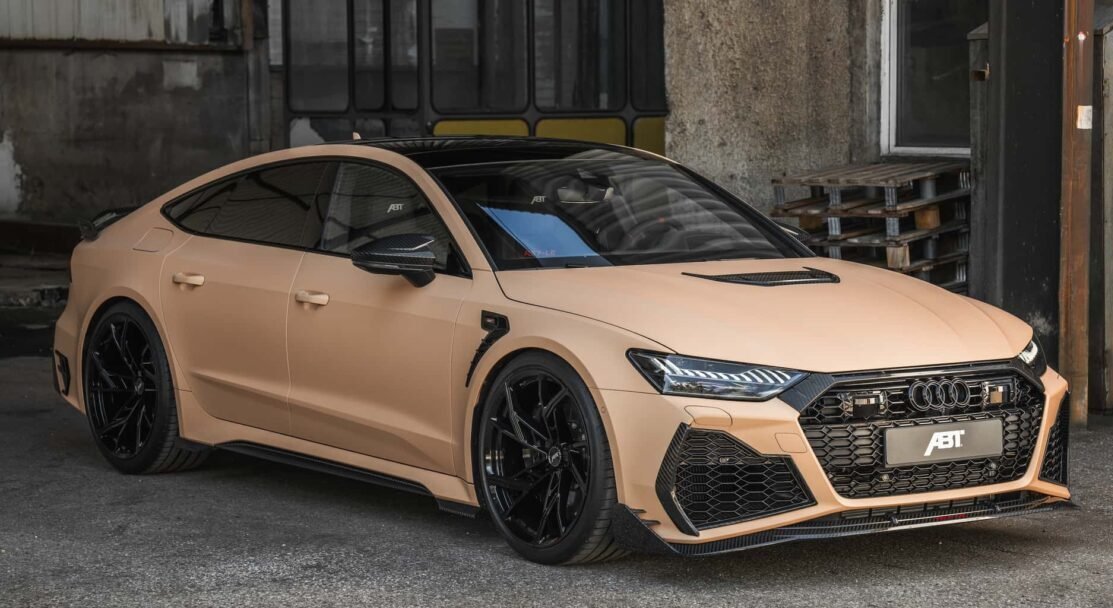
After presenting the RS6 and RS7 Legacy Edition a few months ago, ABT Sportsilne , – a modification company specializing in upgrades for Volkswagen group cars – revealed in recent days the new Legacy Edition line for the RS6 and RS7. Now Audi models have new mechanical features to surpass 900 hp thanks to the new ethanol injection system to generate even more power! Under the hood, the 4.0-liter twin-turbo V8 engine also comes with new turbines, intercoolers and a software update. With the updates, there is now no less than 1,000 horsepower . To complement the RS7’s performance, ABT also included sports springs and stabilizer bars on the front and rear axles to further improve the sports car’s dynamics. Here, the Audi RS7 has received a redesigned look with several updates. The modification company included an aerodynamic body kit with carbon fiber front, side and rear spoilers. To complement the design, the sports coupe also has new 22-inch forged wheels shod with 295/30 tires and carbon fiber mirror caps.
Inside, ABT refined the cockpit with premium fabrics present on the steering wheel with alcantara and “12 o’clock” marking, gear lever, dashboard and seat structure finishes. The special ABT RS7-LE model is also visually distinguished from the standard RS7 by the front seats with the ABT logo on the headrest. Other modifications to the interior include the door entrance lighting and embroidery on the carpets .
The new ABT Sportsline RS7 Legacy Edition will cost 205 thousand euros. It is worth noting that those interested in this kit need to provide the car to carry out the conversion. Performance data has not yet been revealed. However, the model with 1,000 hp should certainly do a zero to 100 km/h time of less than 5 seconds. In addition to outstanding performance, the Luxury
RS 6 and RS 7, which have yet to be announced, justify their hefty price tag of over R$ 600,000 with leather, Alcantara, brushed steel and carbon details. There are more visible decorations, such as interiors that combine. stitch. (Station wagons are red, sedans are blue).
The electronically adjustable sports seats have a heating function, which is not very useful in the Brazilian climate.
From a technical point of view, the highlights are an optional head-up display that projects information for the driver onto the windshield, blind spot warning, a WLAN internet router and a digital four-zone air conditioner that allows independent driving. is. Control). for passengers), adaptive cruise control (adjusts speed to match traffic), and unintentional lane change warning.
Around town, it looks and behaves like a “normal” car, except for the 21-inch wheels, red brake calipers, and large bumpers. With smoother throttle response, a lighter steering wheel and reduced noise from the dual exhaust pipes, simply drive in Comfort driving mode. Freeroad The raison d’être of the
RS 6 and RS 7 Performance becomes clear when driving on German motorways, where there are no speed limits. In Sport mode, the suspension stiffens, the steering wheel becomes unwieldy, the exhaust note radiates into the left lane, and downshifts are thumping.
Instead of the
dual clutch, the 8-speed automatic transmission is conventional (torque converter) and the 4.0 TFSI engine with electronic distribution as required does not affect at all the 71.4 kgfm power he delivers to the four wheels. yeah. In normal use, it is 40% forward and 60% backward.
Hit the gas and you’ll reach 200km/h, just as easily filling the RS 6’s 565-litre boot and the RS7’s 535-litre boot with groceries.
According to Audi, this model reaches 200 km/h in 12.1 seconds and top speed is limited to 250 km/h. However, at the request of the buyer, the dynamic package allows him to increase the speed limit to 280 km / h or 305 km / h.